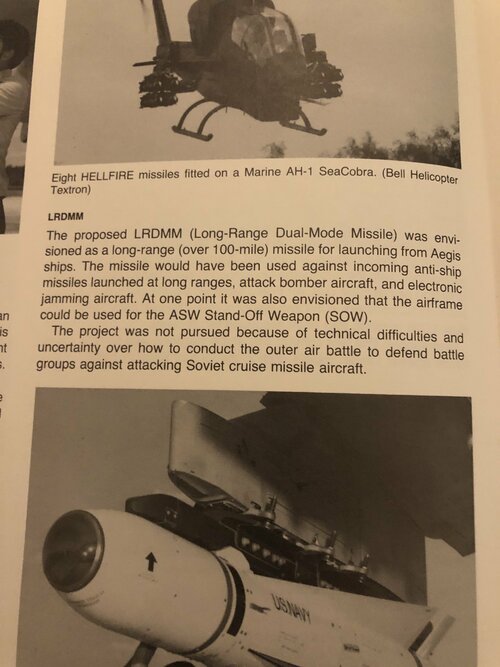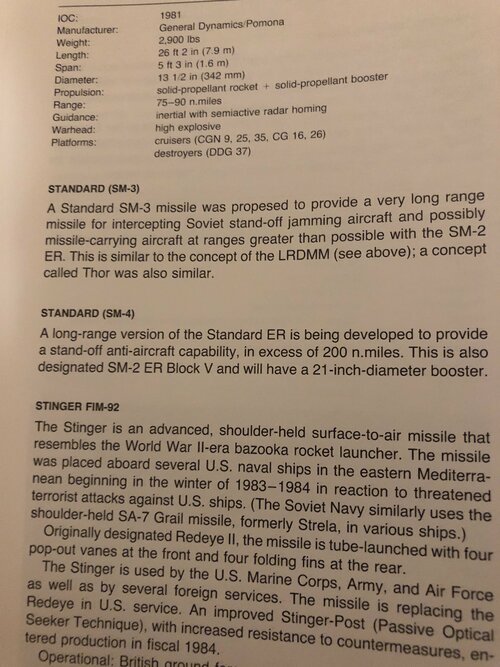that_person
ACCESS: Secret
- Joined
- 25 May 2021
- Messages
- 244
- Reaction score
- 402
Good day peoples of the internet
A couple nights ago I was looking through my copy of Norman Polmar’s Ships and Aircraft of the U.S. Fleet (14th Edition), which I have recently learned was published in 1987, NOT 1986 as I have previously said.
Looking through the Weapons chapter, there are several things that jump out at me. The purpose of this particular thread is to detail them.
———————————————————
First up on our list is the Long-Range Dual Mode Missile, or LDRMM for short. There is this short paragraph describing it, but nothing in detail:
It doesn’t real say much, other than it’s a cancelled long-range SAM, that could attack all kinds of airborne targets. This link here;
tells us the program dates back to at least 1978, and was developed in conjunction/based off the USAF’s ASALM cruise missile. I have also found something saying it was also supposed to be able to attack ships and land targets, found here;
but I have not been able to confirm this in any way, I would take it with a grain of salt.
In all, this is an interesting project that probably never left the archives.
Note: I believe this thread here is referencing the same project: https://www.secretprojects.co.uk/threads/dual-range-missile.3926/
———————————————————
Moving on
———————————————————
This is where things get even fussier. The book has these brief 2 paragraphs on the SM-3 and something called the SM-4/SM-2 ER Block V. This is odd for 4 reasons:
1. The SM-3 is a BMD missile that has just recently entered service.
2. My book was published in 1987.
3. Wikipedia has nothing on either the SM-4 or SM-2 ER Block V. This could just be me being ignorant.
4. What the hell is “Thor”, and why do I suddenly want to know more?
———————————————————
The only conclusions I can draw are:
1. There are 2 SM-3 programs, the modern-day BMD missile, and a 1980s long-range conventional SAM, that was likely cancelled sometime around 1989.
2. There is a cancelled long-range SM-2 variant (with even more range than the SM-2 ER itself) called the SM-4 and SM-2 ER Block V. This was likely also cancelled around 1989.
3. Thor is some other long-range SAM, that I have yet to find anything else on.
———————————————————
This wraps up my post. I know it’s not anything spectacular, but it’s still interesting none-the-less, and figured it was worth posting - the more information on the web, the better. I am very curious to learn more about these concepts, especially Thor. If anyone has any further info, please, do share.
PS: Apologies for the images not being properly embedded. I’m doing this on mobile.
A couple nights ago I was looking through my copy of Norman Polmar’s Ships and Aircraft of the U.S. Fleet (14th Edition), which I have recently learned was published in 1987, NOT 1986 as I have previously said.
Looking through the Weapons chapter, there are several things that jump out at me. The purpose of this particular thread is to detail them.
———————————————————
First up on our list is the Long-Range Dual Mode Missile, or LDRMM for short. There is this short paragraph describing it, but nothing in detail:
It doesn’t real say much, other than it’s a cancelled long-range SAM, that could attack all kinds of airborne targets. This link here;
tells us the program dates back to at least 1978, and was developed in conjunction/based off the USAF’s ASALM cruise missile. I have also found something saying it was also supposed to be able to attack ships and land targets, found here;
but I have not been able to confirm this in any way, I would take it with a grain of salt.
In all, this is an interesting project that probably never left the archives.
Note: I believe this thread here is referencing the same project: https://www.secretprojects.co.uk/threads/dual-range-missile.3926/
———————————————————
Moving on
———————————————————
This is where things get even fussier. The book has these brief 2 paragraphs on the SM-3 and something called the SM-4/SM-2 ER Block V. This is odd for 4 reasons:
1. The SM-3 is a BMD missile that has just recently entered service.
2. My book was published in 1987.
3. Wikipedia has nothing on either the SM-4 or SM-2 ER Block V. This could just be me being ignorant.
4. What the hell is “Thor”, and why do I suddenly want to know more?
———————————————————
The only conclusions I can draw are:
1. There are 2 SM-3 programs, the modern-day BMD missile, and a 1980s long-range conventional SAM, that was likely cancelled sometime around 1989.
2. There is a cancelled long-range SM-2 variant (with even more range than the SM-2 ER itself) called the SM-4 and SM-2 ER Block V. This was likely also cancelled around 1989.
3. Thor is some other long-range SAM, that I have yet to find anything else on.
———————————————————
This wraps up my post. I know it’s not anything spectacular, but it’s still interesting none-the-less, and figured it was worth posting - the more information on the web, the better. I am very curious to learn more about these concepts, especially Thor. If anyone has any further info, please, do share.
PS: Apologies for the images not being properly embedded. I’m doing this on mobile.


